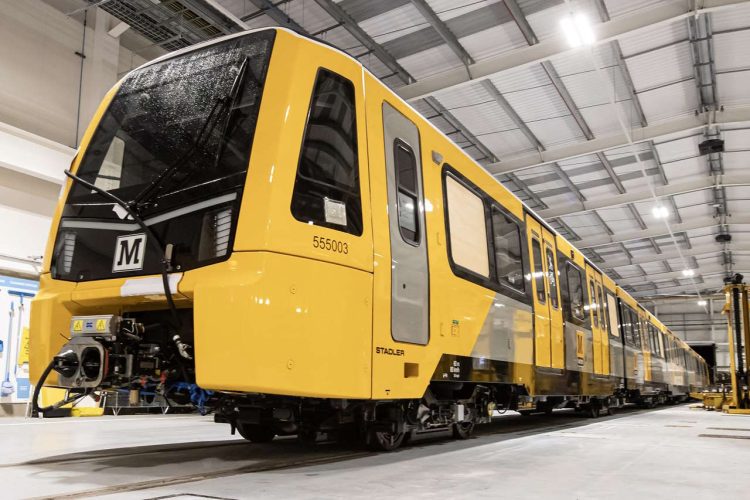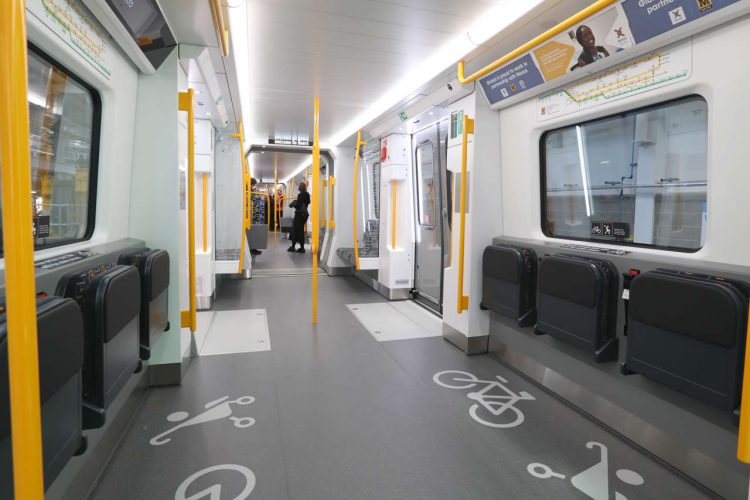Nexus, the public body which owns and operates the Tyne and Wear Metro, has been explaining the volume and complexity of tests it is carrying out on its new fleet of trains.
Ninety thousand individual tests will check all aspects of the fleet, including seats, windscreen wipers, brakes, CCTV, doors, wheels and power supply.
The testing process will establish that the new trains can work safely and smoothly along the Metro’s seventy-seven kilometres of track and through its sixty stations.
Testing and training includes:
- nineteen thousand hours of training time
- training four hundred and eighty staff
- the first few trains completing 37,000 kilometres of running
- compliance with twenty-two thousand standards and clauses
- checking all on-board customer information systems
- checking emergency settings and fail-safe systems.
- scrutinising power consumption, ride quality and performance reliability.
The rigorous testing ensures that the new trains will interface correctly with signalling systems and other infrastructure.
Nexus reckons that this is the biggest project since the system was built in the late 1970s, and one of the most important.
Swiss train building company Stadler is working with Nexus on this testing and commissioning, which is the latest phase of the £362m programme to introduce the new fleet.
Tests are carried out during night time, when trains are not running in passenger service. Nexus says that the testing involves the same level of detail that a big car manufacturer undertakes when bringing a new model to the market.

Testing began when the first three Stadler trains arrived in North East England in March this year. The first test were of basic functionality, and took place within the depot. Then the first trains began testing on the network in May.
The first five new trains will each need to run for ten thousand kilometres without developing faults before they can enter passenger service.
Key functionality testing includes:
- the driver’s cab
- wheels
- passenger alarms
- doors, train horn, windscreen wipers, air conditioning
- radio systems
- information screens
- emergency evacuation
- ride comfort
- passenger emergency intercom
- infrastructure interface: platforms, signals and power supply
- automatic sliding step
- power consumption
- braking, including emergency braking
- couplers
- traction performance (reliability)
- lighting (interior and exterior)
- seats, hand rails and grab poles
- CCTV
- pantographs
- battery technology
Stadler is building a total of forty-six new Metro trains for Nexus, which will enter service in phases, with the aim to have them all in service in 2025. Stadler has delivered three new trains so far, with more due to arrive later this year.
The Class 555 Stadler train has been designed specifically for the Tyne and Wear Metro, whose drivers will be trained at the controls of the new train.
Passengers were consulted about the design of the trains, and as a result, will include modern features such as linear seating, charging points and air conditioning. Nexus promises that they “will deliver a step-change in accessibility“, including features such as an automatic sliding step at every door. This will make travel easier for Metro’s fifty thousand wheelchair passengers as well as for people travelling with children’s buggies, luggage or bicycles.

Interim Managing Director at Nexus, Cathy Massarella, said: “Testing is really detailed and it’s absolutely critical to get the new Stadler trains ready for customer service.
“We are leaving no stone unturned in what is probably the biggest and most important project since the Metro system was first built.
“Everything on the train needs to be tested and checked thoroughly and this is something that we are doing in conjunction with our colleagues at Stadler.
“There is great attention to detail. It’s very much like the testing that a big car company undertakes when it’s preparing to unveil a new model. The trains need to be put through their paces to ensure that they are ready for daily service.
“These trains are a world away from the current fleet. They have digital technology and much of the testing can be done by plugging a laptop computer into the trains’ onboard computer system.
“Our customers won’t see the new trains running around the network as the testing is currently being undertaken between midnight and the early hours when the network is closed. However, there will be testing in daylight hours later this year.
“Thousands of inspection criteria need to be met, and fault free running targets achieved before Nexus officially accepts the trains and we put the first one into service.
“All of the teams involved in testing are working tirelessly. It’s a historic project for Metro to bring a new fleet of trains into service and we are making sure we get everything right.
“The Stadler trains are going to be transformative, and we are really excited to get them into service. They have been shaped by customers, employees, trade unions and specialist user groups. We believe this to have been the most far-reaching consultation yet staged into a new train design. Over 23,000 customer responses have helped to shape the design.”
Claudius Oblasser, Technical Project Manager at Stadler, said: “Testing and commissioning is a critical stage in the production of new trains. It sees thousands of safety and performance tests carried out to make sure they are ready for service and compatible with the infrastructure they will operate on. We use this period to iron out faults and stress-test the trains to enable them to perform well for decades to come.”





Responses
The new Tyne and Wear Metro Class 555 does look very smart and the interiors, seats, lighting etc are also very nice and modern. Looking forward to seeing them in service from next year.